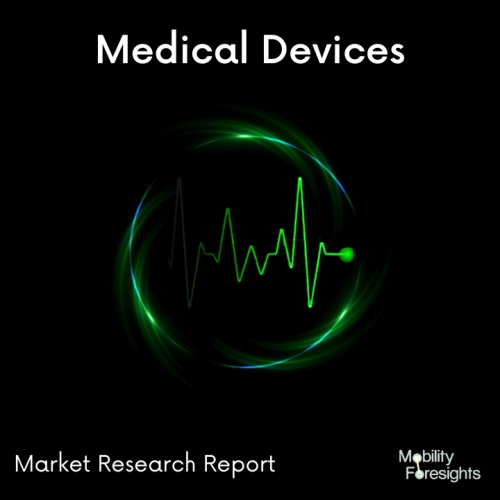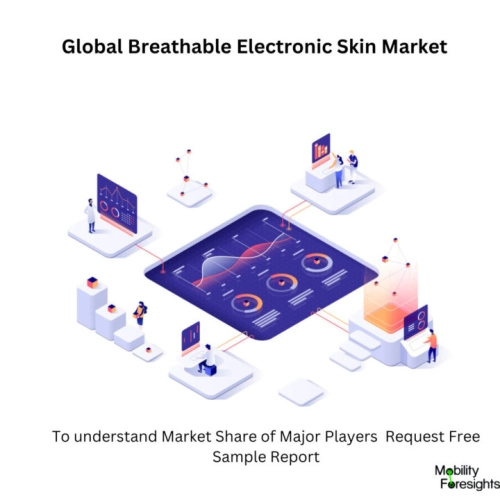
- Get in Touch with Us

Last Updated: Apr 25, 2025 | Study Period: 2023-2030
A breathable electronic skin (E-skin) that can detect pressure and strain using distinct signals. The E-skin has microscaled pores for breathability and three-dimensional microcilia for superhydrophobicity thanks to the synergistic impact of magnetic attraction and nanoscaled aggregation.
When pressure is applied, conductive microcilia flex, creating enough connections to reduce resistance, whereas stretching separates the conductive materials, increasing resistance. It functions as a flexible and wearable sensor that can recognise various mechanical stimulations from the human body and produce non-overlapping electrical signals.

The Global Breathable Electronic Skin market accounted for $XX Billion in 2022 and is anticipated to reach $XX Billion by 2030, registering a CAGR of XX% from 2023 to 2030.
Breathable electronic skins have seen fast development in recent years for use in daily physiological signal monitoring applications. Breathable (air-permeable) e-skins have gained significant interest in recent years due to the growing demand for long-term and pleasant physiological signal monitoring by e-skin.
Sweat buildup can be prevented by the breathable e-skin, which also vastly increases comfort when worn for an extended period of time.
The two primary kinds of breathable e-skins for daily long-term physiological signal monitoring can be separated based on the sorts of monitoring signals.
One is the breathable e-skin electrode for electrophysiological signal monitoring, such as the electrocardiograph (ECG) e-skin electrode, electro-oculography (EOG) e-skin electrode, electromyography (EMG) e-skin electrode, electroencephalograph (EEG) e-skin electrode, etc.
The second is breathable e-skin sensors, which are employed to recognise both physical and chemical physiological signals (such as pulses, breath sounds, blood pressure, body temperature, etc). (glucose, ethanol, electrolytes, etc.).
Additionally, there are breathable multifunctional e-skins that can track a variety of physiological signs. The functional materials, architectures, and manufacturing procedures of breathable e-skins vary depending on the varied physiological signals or multiple physiological signals monitoring requirements.
Recent developments in breathable e-skin electrodes have offered sensors and systems for daily physiological signal monitoring. Systematically discussed aspects of their designs include useful materials, structures, fabrication techniques, and performances.
The usual multifunctional, highly integrated, and intelligent e-skin systems are then demonstrated. These systems are capable of long-term in situ sensing, processing, and diagnosis of physiological signals in daily life and daily autonomous labour.
| Sl no | Topic |
| 1 | Market Segmentation |
| 2 | Scope of the report |
| 3 | Abbreviations |
| 4 | Research Methodology |
| 5 | Executive Summary |
| 6 | Introduction |
| 7 | Insights from Industry stakeholders |
| 8 | Cost breakdown of Product by sub-components and average profit margin |
| 9 | Disruptive innovation in the Industry |
| 10 | Technology trends in the Industry |
| 11 | Consumer trends in the industry |
| 12 | Recent Production Milestones |
| 13 | Component Manufacturing in US, EU and China |
| 14 | COVID-19 impact on overall market |
| 15 | COVID-19 impact on Production of components |
| 16 | COVID-19 impact on Point of sale |
| 17 | Market Segmentation, Dynamics and Forecast by Geography, 2023-2030 |
| 18 | Market Segmentation, Dynamics and Forecast by Product Type, 2023-2030 |
| 19 | Market Segmentation, Dynamics and Forecast by Application, 2023-2030 |
| 20 | Market Segmentation, Dynamics and Forecast by End use, 2023-2030 |
| 21 | Product installation rate by OEM, 2023 |
| 22 | Incline/Decline in Average B-2-B selling price in past 5 years |
| 23 | Competition from substitute products |
| 24 | Gross margin and average profitability of suppliers |
| 25 | New product development in past 12 months |
| 26 | M&A in past 12 months |
| 27 | Growth strategy of leading players |
| 28 | Market share of vendors, 2023 |
| 29 | Company Profiles |
| 30 | Unmet needs and opportunity for new suppliers |
| 31 | Conclusion |
| 32 | Appendix |